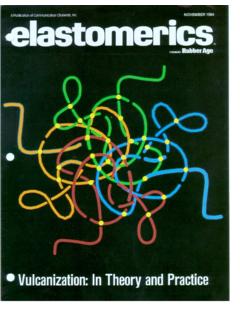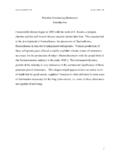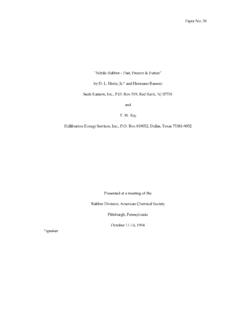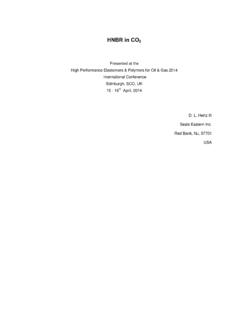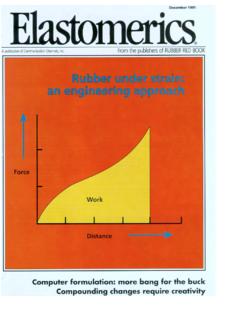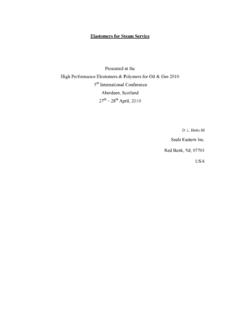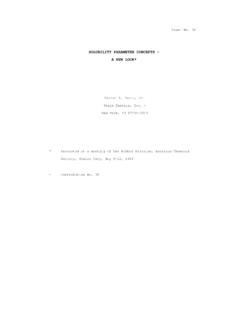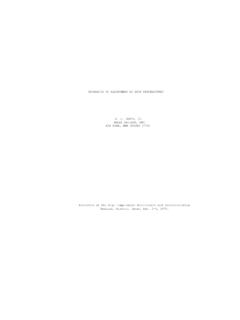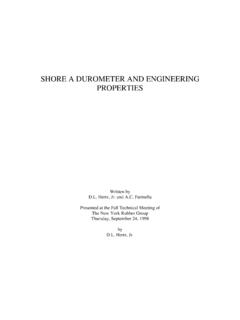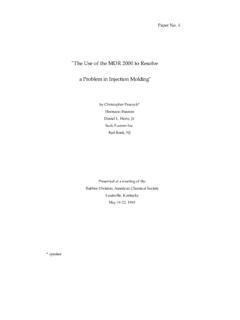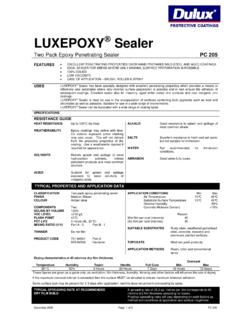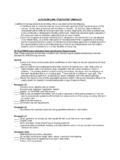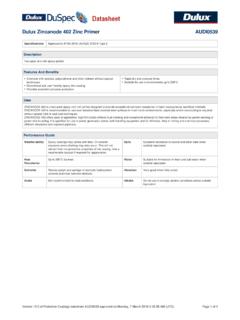Transcription of LOW TEMPERATURE TESTING OF ELASTOMERS
1 LOW TEMPERATURE TESTING OF ELASTOMERS Presented at the Spring Technical Meeting of the New York Rubber Group Thursday, March 25, 1999 By, Andrew C. Farinella and Daniel L. Hertz, Jr. 1 LOW TEMPERATURE data Two basic questions (as suggested by John Ferry, 1986 [4]) that an engineer designing a rubber seal might want to ask are: 1. After a sudden stress how long will it take for the elastomer to adjust its shape to maintain the seal ? 2. If there are oscillating stresses, will there be sufficient time in the period of oscillation for the elastomer to adjust its shape to maintain the seal ? Correct answers to these questions may have saved the lives of the astronauts aboard the Space Shuttle Challenger.
2 Thus it is imperative that we find the answers, prepare for the future and avert similar tragedies. A third question for a design or R&D engineer might want to ask is: 3. What tests can I use in the lab to analyze and verify my design? In this paper we will discuss various historical attempts to answer these questions and propose alternate methods. PURPOSE OF ENGINEERING data The key question we must ask here is why do we do these various tests for rubber properties? The primary answers are 1) Quality Control and 2) to use the test results to predict performance under design conditions. For example, if we want to design a rubber hanger to support 500 lbs.
3 , we can use the tensile strength of the material as a design tool. From the equation: Eq. 1 APSMaxU= Strength = Max Load/Cross Sectional Area, we know the tensile strength of the material and the maximum load corresponding to a given cross sectional area. For our design, we know the load to bear, and the strength of the material. The unknown is the size (cross sectional area) of the hanger. Rearranging, we can solve for the required area: Eq. 2 uDesignMinSPA= For our example, let s assume a tensile strength of 2,500 psi. The load to bear is 500 lbs. Thus the cross section must be at least in2; for a square cross section, the length of a side is about inches (the square root of ).
4 This example assumes that design conditions are (nearly) the same as test conditions. That is, the loading is (nearly) static and tensile, and the TEMPERATURE is the same as test conditions. Tensile strength is a well-defined test, easily correlated for use in design*. The whole purpose of engineering data is to classify and characterize the properties/behavior of engineering materials in order to predict their behavior under other geometric, loading, or TEMPERATURE conditions. This reduces the amount of trial and error engineering and significantly reduces cost and increases speed of design. Tests that cannot be correlated to other sets of conditions are of little use to the design engineer.
5 Mooney viscosity and many of the low TEMPERATURE tests are just a few examples. * This is presented as a simple example for linear materials; other factors are involved for elastomeric materials. 2 EXAMPLE OF POOR USE OF ENGINEERING data Mooney Viscometer As a quick example, let s look at the typical industry use of the Mooney viscometer or cure rheometer. Generally it is used as a quality control tool for various rubber compounds. Torque versus time is plotted as the rotor either rotates (constant speed) or oscillates (constant frequency). Be aware that viscosity (and consequently the measured torque) varies with shear rate.
6 That is, the ratio of torque to rotor speed is NOT a constant value. In fact, the viscosity of many polymer melts actually looks like this: Viscosity vs. Shear Rate* + + + + + +050110100 Shear Rate (s-1)*Bird, Armstrong, Hassager, Figure 1 It is worth noting that Mooney viscometers impose a shear rate of approximately 1 s-1, while typical shear rates in injection molding operations are in the neighborhood of 1000 s-1. This information, combined with the chart above, should raise a red flag to anyone using a Mooney viscometer as a check for injection molding operations. Not only does the Mooney viscometer use a single (low) shear rate [6], but also its data cannot be used to predict behavior in other geometric configurations.
7 That is, there is no definable state of stress for the sample in a Mooney viscometer. INTRODUCTION TO MATERIAL BEHAVIOR Perfectly Elastic Spring Given a sinusoidal deflection (or similarly, strain) input, there will be a sinusoidal stress output with no phase lag- tan delta is zero. No dissipation is occurring. The following two curves show a sinusoidal strain input (black curve, y-axis is deflection in inches) and a perfectly elastic force response (red curve, y-axis in units of pounds force) versus time. The curves are exactly in phase. That is, the only difference between the two curves is in magnitude; both curves have the same argument, namely t.
8 Thus the input deflection is: 3Eq. 3 )sin(tAy = and the measured force response is: Eq. 4 )sin(tkAF = A Purely Elastic System- A Spring Figures 2a and 2b As an example, think of a steel spring. The spring can be stretched between two fixed points and years later, the spring will not lose the stored energy. We can get the energy back and perform work even after a large amount of time. The further you stretch the spring, the more energy is stored, and it doesn t matter how fast you stretch the spring, only how far. Purely Viscous Fluid Given a sinusoidal deflection (or similarly, strain) input, there will be a sinusoidal stress output with a 90 phase lag.
9 Therefore, tan delta is undefined. This means that the input and output curves will differ both in magnitude and in phase. The phase difference is exactly 90 . The fluid does not store any energy- all the work is dissipated. Thus the input deflection is the same as before, and the output force is: Eq. 5 [][])sin()cos(2 + = = = tActAcycF A Purely Viscous System- A Dashpot Figures 3a and 3b As an example, think of a damper on an office door. The faster you push the door, the harder it is to close. Unlike the spring, if you push the door open, it will not close after you let go; the damper does not store any energy. The force it takes to move the damper doesn t depend on how far you move the damper, only how fast.
10 4 Viscoelastic Materials Sinusoidal Strain Input, Sinusoidal Stress Output- Phase Lag is somewhere between 0 and 90 ; there is some storage and some dissipation. The sinusoidal deflection input is the same as before, but the output is a combination of the elastic and viscous responses: Eq. 6 )cos()sin(tActkAF = This response can also be expressed as a single sine wave as follows: Eq. 7 )sin( + =tfF, where the amplitude of the response is Eq. 8 )(2222 ckAf+= and the negative sign is simply an indicator of the direction of the forces. A Viscoelastic System- Polymers! Figures 4a and 4b As an example, think of a rubber band. There is some storage- you can stretch the rubber band and launch it ( recover the energy).
